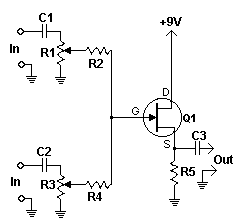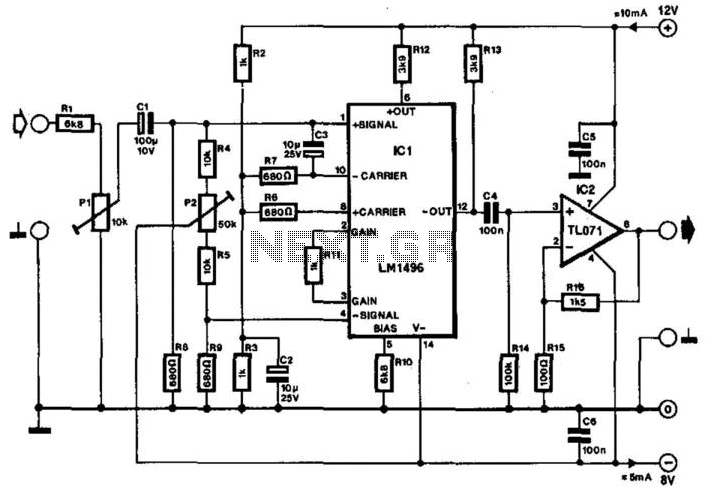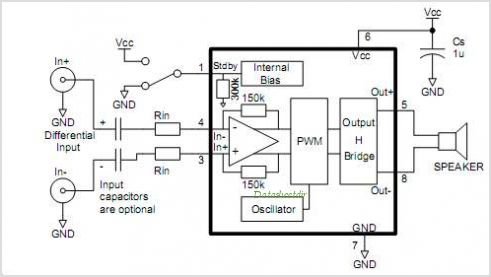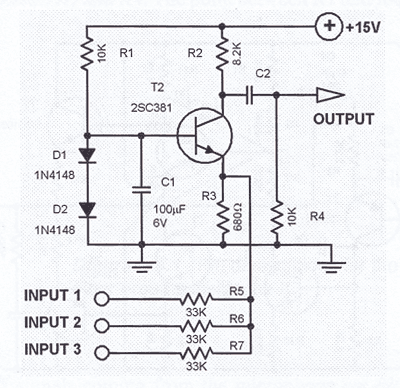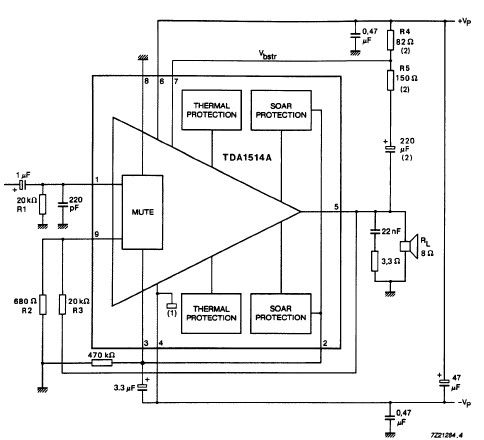
Audio Electronics
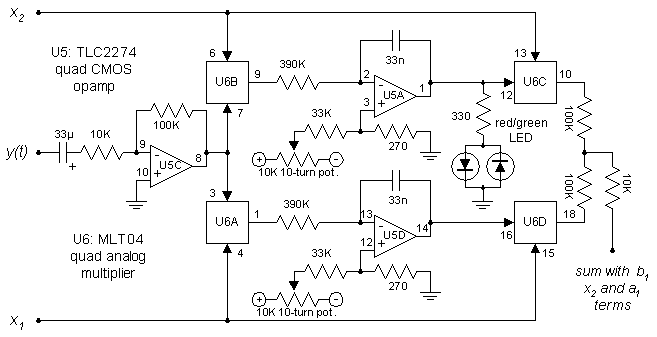
This document outlines the use of a desktop computer to perform complex arithmetic for designing state-variable filters intended for audio applications. It features the construction of a tunable notch filter for measuring harmonic distortion. The article has been well edited and presented by Audio Amateur Corp., although several typographical errors need clarification. For instance, Figure 5 on page 13 incorrectly labels both inputs on the left as "Speaker Level Input." The differential input J1 is correctly labeled, while J2, the single-ended input, should be labeled "Line Level Input." The schematic diagrams omit the power supply connections to the operational amplifiers, which should be connected as follows: +15 Vdc (filtered, regulated, and bypassed) to pin 8 of each LF353, and -15 Vdc (filtered, regulated, and bypassed) to pin 4 of each LF353. On page 14, the section titled "Constructing the Prototype" mentions that distortion was higher when the preamp U4B was configured for unity gain. This increase in distortion is attributed to a design error, which can be easily rectified. The unique distortion mechanism of JFET input op-amps becomes significant in non-inverting configurations like U4B in Figure 5. The input capacitance's variation with common mode voltage causes non-linearity at high frequencies when the source impedance is elevated, which is the case for the inverting input of U4B in unity gain. The solution involves configuring SW3 to shunt R26 with a smaller parallel resistance when unity gain is selected. The circuit diagram illustrating this correction is provided. Further insights were gained from a Burr-Brown data sheet on the OPA 134 Audio Operational Amplifier. Additionally, the values of R25, R26, and C21 were modified to achieve an amplifier gain of exactly 10. An enhancement mentioned on page 17 under "Further Development" has been completed, utilizing the MLT04 quad analog multiplier from Analog Devices to implement an auto-tune and auto-null add-on circuit, simplifying the notch filter's use, particularly for measuring distortion levels of 0.1% or less. The complete schematic is included, indicating that this circuit can operate without modifications to the original notch filter. In the original prototype, a jumper was added for power, ground, x2, y(t), x1, and an input to the summation of b1, x2, and a1. The power supply was replaced with a +/- 5 Vdc unit, as both the TLC2274 and MLT04 require +/- 5 Vdc supplies. This change minimally affects the notch filter's performance but does constrain headroom. The design closely follows that of C. Lau [1980], substituting multipliers at U6A and U6B for synchronous detection instead of choppers. A bi-color LED has been added to indicate whether coarse tuning should be adjusted up or down. The front panel fine-tune and null adjustments do not interfere with the automatic circuit and can remain centered. Ten-turn potentiometers are utilized to account for offset voltages in the multipliers and operational amplifiers. With a 1 Vrms input exhibiting very low distortion, the trim pots should be adjusted iteratively until the notch filter output is minimized. The front panel fine-tune and null adjustments can be jogged to observe the automatic adjustments take effect. The auto-tune and auto-null circuits function independently and can be disabled by shorting either or both of the 33nF integrating capacitors.
The circuit schematic for the tunable notch filter is designed to facilitate harmonic distortion measurement in audio applications. It employs state-variable filter topology, which allows for precise tuning and adjustment of filter characteristics. The operational amplifiers, specifically the LF353, are configured to provide the necessary gain and filtering properties, with careful attention to power supply requirements to ensure optimal performance.
The inclusion of the MLT04 quad analog multiplier enhances the notch filter's functionality, enabling automatic tuning and nulling of the filter response. This feature is particularly beneficial when dealing with low distortion levels, as it simplifies the process of achieving accurate measurements.
The design considerations regarding the JFET input op-amps highlight the importance of understanding the operational characteristics of the components used, particularly in non-inverting configurations. The adjustments made to the circuit, including the shunting of resistors and the modification of component values, ensure that the filter operates within the desired parameters while minimizing distortion.
Furthermore, the addition of visual indicators such as the bi-color LED provides an intuitive interface for users, allowing for real-time feedback during the tuning process. The use of ten-turn potentiometers allows for fine adjustments, which are critical in achieving the desired performance from the notch filter.
Overall, the detailed schematic and accompanying descriptions provide a comprehensive guide for constructing and utilizing a tunable notch filter for audio applications, addressing common pitfalls and offering solutions for optimal performance.How to use a desktop computer to solve the complex arithmetic needed to design state-variable filters for audio use. Construction of a tunable notch filter for measuring harmonic distortion is featured. Audio Amateur Corp. did a beautiful job (as always)of editing and presenting my article. For those of you who are planning to build my notch filter however, several typos snuck in which should be clarified. Figure 5 on page 13 has both inputs on the left labeled as "Speaker Level Input". J1, the differential input, is correctly labeled, but J2, the single ended input, should have been labeled "Line Level Input". In the schematic diagrams, I didn`t show the power supply connections to the opamps, but probably should have.
Connect +15 Vdc (filtered, regulated, and bypassed) to pin 8 of each LF353. Connect -15 Vdc (filtered, regulated, and bypassed) to pin 4 of each LF353. On page 14 under the heading "Constructing the Prototype" I make a statement regarding the input preamp U4B that "distortion was higher when I configured the preamp for unity gain. " The increase in distortion is actually due to a design error on my part which is easily corrected. It turns out that JFET input opamps have a unique distortion mechanism that only comes into play when used in a non-inverting circuit, as is U4B in Figure 5.
Input capacitance varies with common mode voltage, making the inputs non-linear at high frequencies when the source impedance is high. This is the case for the inverting input of U4B when unity gain is selected. The solution is to configure SW3 so that R26 is shunted by a much smaller parallel resistance when unity gain is selected.
The following circuit diagram shows the correction: I learned about this issue from a Burr-Brown data sheet, available online at: OPA 134 Audio Operational Amplifier. I also changed the values of R25, R26, and C21 so that the amplifier gain is now exactly `times 10`. I`ve already finished one of the enhancements I mentioned on page 17 under the heading "Further Development".
I`ve used the MLT04 quad analog multiplier from Analog Devices to implement an auto-tune and auto-null add-on circuit. This makes the notch filter much easier to use, especially when measuring distortion levels of 0. 1% or less. Here is the complete schematic: Note that this circuit can be used without modifying the original notch filter circuit.
On my original prototype, I just added a jumper with connections for power, ground, x2, y(t), x1, and an input to the summation of b1, x2, and a1. I did however have to replace the power supply with a +/- 5 Vdc unit, since both the TLC2274 and the MLT04 must be used with +/- 5 Vdc supplies.
This had little effect on notch filter performance, but does limit headroom quite a bit. I follow the design of C. Lau [1980] pretty closely, although I used multipliers at U6A and U6B instead of choppers for synchronous detection. I`ve also added a bi-color LED to indicate if coarse tuning should be adjusted up or down. The front panel fine tune and null adjustments don`t affect operation of the automatic circuit, and can be left centered.
The 10-turn potentiometers are used to account for offset voltages in the multipliers and op-amps. With a 1 Vrms input having very low distortion, adjust the trim pots iteratively until notch filter output is minimized. Jog the front panel fine tune and null adjustments to watch the automatic adjustments take over. The auto tune and auto null circuits operate independently, and can be inhibited by shorting across either or both of the 33nF integrating capacitors.
🔗 External reference
The circuit schematic for the tunable notch filter is designed to facilitate harmonic distortion measurement in audio applications. It employs state-variable filter topology, which allows for precise tuning and adjustment of filter characteristics. The operational amplifiers, specifically the LF353, are configured to provide the necessary gain and filtering properties, with careful attention to power supply requirements to ensure optimal performance.
The inclusion of the MLT04 quad analog multiplier enhances the notch filter's functionality, enabling automatic tuning and nulling of the filter response. This feature is particularly beneficial when dealing with low distortion levels, as it simplifies the process of achieving accurate measurements.
The design considerations regarding the JFET input op-amps highlight the importance of understanding the operational characteristics of the components used, particularly in non-inverting configurations. The adjustments made to the circuit, including the shunting of resistors and the modification of component values, ensure that the filter operates within the desired parameters while minimizing distortion.
Furthermore, the addition of visual indicators such as the bi-color LED provides an intuitive interface for users, allowing for real-time feedback during the tuning process. The use of ten-turn potentiometers allows for fine adjustments, which are critical in achieving the desired performance from the notch filter.
Overall, the detailed schematic and accompanying descriptions provide a comprehensive guide for constructing and utilizing a tunable notch filter for audio applications, addressing common pitfalls and offering solutions for optimal performance.How to use a desktop computer to solve the complex arithmetic needed to design state-variable filters for audio use. Construction of a tunable notch filter for measuring harmonic distortion is featured. Audio Amateur Corp. did a beautiful job (as always)of editing and presenting my article. For those of you who are planning to build my notch filter however, several typos snuck in which should be clarified. Figure 5 on page 13 has both inputs on the left labeled as "Speaker Level Input". J1, the differential input, is correctly labeled, but J2, the single ended input, should have been labeled "Line Level Input". In the schematic diagrams, I didn`t show the power supply connections to the opamps, but probably should have.
Connect +15 Vdc (filtered, regulated, and bypassed) to pin 8 of each LF353. Connect -15 Vdc (filtered, regulated, and bypassed) to pin 4 of each LF353. On page 14 under the heading "Constructing the Prototype" I make a statement regarding the input preamp U4B that "distortion was higher when I configured the preamp for unity gain. " The increase in distortion is actually due to a design error on my part which is easily corrected. It turns out that JFET input opamps have a unique distortion mechanism that only comes into play when used in a non-inverting circuit, as is U4B in Figure 5.
Input capacitance varies with common mode voltage, making the inputs non-linear at high frequencies when the source impedance is high. This is the case for the inverting input of U4B when unity gain is selected. The solution is to configure SW3 so that R26 is shunted by a much smaller parallel resistance when unity gain is selected.
The following circuit diagram shows the correction: I learned about this issue from a Burr-Brown data sheet, available online at: OPA 134 Audio Operational Amplifier. I also changed the values of R25, R26, and C21 so that the amplifier gain is now exactly `times 10`. I`ve already finished one of the enhancements I mentioned on page 17 under the heading "Further Development".
I`ve used the MLT04 quad analog multiplier from Analog Devices to implement an auto-tune and auto-null add-on circuit. This makes the notch filter much easier to use, especially when measuring distortion levels of 0. 1% or less. Here is the complete schematic: Note that this circuit can be used without modifying the original notch filter circuit.
On my original prototype, I just added a jumper with connections for power, ground, x2, y(t), x1, and an input to the summation of b1, x2, and a1. I did however have to replace the power supply with a +/- 5 Vdc unit, since both the TLC2274 and the MLT04 must be used with +/- 5 Vdc supplies.
This had little effect on notch filter performance, but does limit headroom quite a bit. I follow the design of C. Lau [1980] pretty closely, although I used multipliers at U6A and U6B instead of choppers for synchronous detection. I`ve also added a bi-color LED to indicate if coarse tuning should be adjusted up or down. The front panel fine tune and null adjustments don`t affect operation of the automatic circuit, and can be left centered.
The 10-turn potentiometers are used to account for offset voltages in the multipliers and op-amps. With a 1 Vrms input having very low distortion, adjust the trim pots iteratively until notch filter output is minimized. Jog the front panel fine tune and null adjustments to watch the automatic adjustments take over. The auto tune and auto null circuits operate independently, and can be inhibited by shorting across either or both of the 33nF integrating capacitors.
🔗 External reference
